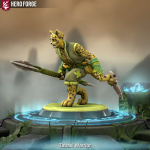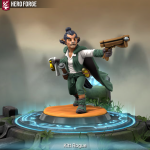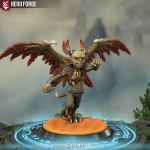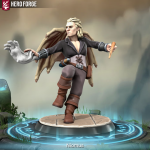NarlethDrider said:
Go ahead & send them (NarlethDrider (at) aol.com)

, Maybe they'll finally bust the boil of creativity that seems to resist so much
Done.
_________________________________________________
THE CAT RACES OF HARQUAL
Harqual's racial diversity doesn't end with the demihuman races. Many races called Harqual home long before the barbarian people came across the frozen north from Kanpur, all those eras ago. The gray elves were one, while the rakasta and tabaxi were two others. However, it wasn't until after the followers of Cronn were entrenched in the Northland that the rakasta and the tabaxi began to evolve into races equal to the humans. Eventually, the kitt evolved from the close kinship of the halflings and rakasta of the south, but I'm getting ahead of myself . . .
THE RAKASTA
The rakasta of Harqual are the same as the rakasta of Janardûn or the rakasta of Kanpur. Only the unique simbasta, native to the sub-regions of Kanpur known as the Dark Continent, the Land of Fate, and the Indjiran Peninsula can be considered a different race. However, the rakasta of Harqual are vastly different than the rakasta native to other continents.
What makes Harqual prides different is the schism that exists between the rakasta of the savannas and the rakasta that have become civilized in the urban communities of the Far South. Also, the rakasta of Harqual are limited in the range of territory they inhabit. There aren't any rakasta prides north of the Great Expanse and very few of them would even venture into that desert. The reason for this is unknown but most believe it is due to the alliance forged between Cronn and the cat-god known as the Lord of the rakasta, Rel. Rel is a member of the Pantheon of the North, which confuses outlanders not native to Harqual as the rakasta have no desire to infringe upon the lands of the north.
Rakasta also have a fear of water so very few become sailors and those prides that have had relocated to, say, the Isle of Dread south of Harqual are content to live there. However, most rakasta live a nomadic existence across the savannas of the Far South, trading their wares to their allies: rockwood gnomes, southern-dwelling elves, Torin dwarves, and lightfoot halflings. Rarely, will the savanna rakasta have contact with humans or other humanoid races.
Rakasta culture is unique, somewhat mystical, and concerned primarily with battle and honor. They never betray one of their own unless the rakasta, in question, is an outcast from the society he grew up in. If rakasta do not follow these principles set down by their ancestors, they are branded and cast out of their society and have a -2 penalty to all Charisma based skills when dealing with other rakasta. The rakasta Code of Honor (on Harqual) is based on the following general principles.
- Never betray kin.
- Never kill for the sake of blood-lust or vengeance.
- Never battle a lesser foe if it can be avoided.
- Always honor the dead, even of the enemy.
- Life before death.
- Always defer judgment to the chosen of Rel and Cronn.
- Honor Northerners with good hearts, with friendship.
Rakasta Traits
Rakasta benefit from a number of racial traits:
- +4 to Dexterity, +2 to Wisdom. Rakasta are known for being strong spiritually, as well as being fleet-footed.
Medium-sized. As Medium-size creatures, rakasta have no special bonuses or penalties due to their size.
- Monstrous Humanoid: Rakasta are monstrous humanoids, and are therefore immune to spells that only affect humanoids, such as charm person.
- Speed: Base land speed is 30 ft.
- Darkvision out to 60 feet. Darkvision is black and white only, but it is otherwise like normal sight, and rakasta can function just fine with no light at all.
- Weapon Familiarity: Rakasta treat kasa as martial weapons, rather than exotic weapons.
- Racial Hit Dice: A rakasta begins with two levels of monstrous humanoid, which provide 2d8 Hit Dice, a base attack bonus of +2, and base saving throw bonuses of Fort +3, Ref +3, Will +0.
- Racial Skills: A rakasta's monstrous humanoid levels give it skill points equal to 5 x (2 + Int Modifier, minimum 1). Its class skills are Balance, Hide, Jump, Listen, Move Silently, and Spot. Rakasta receive a +4 racial bonus to Balance, Hide, and Move Silently checks. *In areas of tall grass or heavy undergrowth, the Hide bonus improves to +12. Rakasta also have a +2 bonus to the Listen skill (which they must still acquire normally).
- Racial Feats: A rakasta's monstrous humanoid levels give it one feat. A rakasta receives Weapon Finesse as a bonus feat.
- Blind-Fight: Rakasta automatically gain the Blind-Fight feat at their 1st character level.
- Cat's Grace (Su): Rakasta have excellent balance and reflexes, taking only half damage from any fall.
- Detect Invisible Foes (Ex): When confronted with invisible creatures, a rakasta receives a +4 bonus to any saving throws made for detection. A rakasta automatically gets a Will saving throw (with the bonus) when an invisible creature approaches within 10 feet and during every round the invisible being remains that close. The rakasta does not automatically know where the invisible creature is, just that it is close by; locating it still requires other clues. Rakasta can also use this ability to detect the presence of ethereal creatures, such as ghosts, phase spiders, or someone wearing plate mail of etherealness. They recognize the difference between things ethereal and those simply invisible but gain no special attack or defense capabilities against ethereal beings.
- Pounce (Ex): If a rakasta leaps upon a foe during the first round of combat, it can make a full attack even if it has already taken a move action.
- Improved Grab (Ex): To use this ability, the rakasta must hit with its claw attacks.
- Scent (Ex): A rakasta can detect approaching enemies, sniff out hidden foes, and track by sense of smell. Range is 30 ft. If upwind, the range increases to 60 ft.; if downwind, it drops to 15 ft.
- Because of their keen senses, rakasta must make an additional Fortitude saving throw (DC 15) against attacks based on sound (such as a banshee's wail or a harpy's song) beyond any save normally required.
- Water Penalty: Most rakasta have an inherent fear of the water and suffer a -2 racial penalty to all skill checks and saving throws made while exposed to water deeper than 3 feet.
- +1 natural bonus to armor class.
- Natural Attacks: Rakasta may attack with two claws (1d3) and bite (1d6) and are always treated as being armed when using their natural attacks.
- Automatic Languages: Rakasta. Bonus Languages: Common, Elven, Giant, Gnome, Halfling, Kitt, Orc, and Sylvan.
- Favored Class: Fighter. A multiclass rakasta's fighter class does not count when determining whether he suffers an XP penalty for multiclassing.
- Level Adjustment: +4.
 THE TABAXI
THE TABAXI
While the rakasta developed true sentience during the First Era with the coming of Rel to Kulan, the tabaxi didn't evolve as quickly. Not until Tu was given the power of the divine over the tabaxi (by Mirella) during the Second Era. Tu had been the first of the great tigers to walk upright and dominate his fellow kin. These anthropomorphic tigers became the tabaxi.
Those that remained loyal to Tu were granted true sentience first, and were brought into the Priesthood of Tu. The other tabaxi were eventually brought in to the expanding civilization as the need for a lower caste developed. It is true that not all tabaxi were created equal. (The most notable of these sub-races of tabaxi are known as the Warriors of Tu, a caste of warriors completely loyal to the priests of Tu. Warriors of Tu cannot be priests, however.)
The tabaxi thrived until the Divinity War broke out between the North Gods and Sword Gods. Soon after the Mortals War began, the tabaxi were pulled into the conflict like every other race on the continent. Being neutral in the conflict didn't endear them to anyone, and soon the tabaxi were hard-pressed on all sides. The only thing that saved them was the direct intervention of Tu.
Tu had always been a proud and strong but as the decades past he became convinced that his people were destined to rule all of Harqual. When the Mortals War started, the cat-god had hoped the followers of the Interlopers would destroy each other leaving the tabaxi to rule the continent. And while these followers did slaughter each other, they simply reproduced too fast to die off. Tu saw his people outnumbered and isolated.
He was furious, to say the least. He sent powerful proxies to aid his followers as well as giving a part of his essence to his high priests. Thus, were the first avatar-priests created. The tabaxi soon crushed all those living near the Storm Jungle, expanding farther north and east to challenge the Empire of Swords and the rakasta of the south.
The tabaxi threat did not go unnoticed, however. Cronn, the Lord of the North left the field during the Last Battle on the shores of Lunia to come to Harqual to battle Tu. The two gods fought through the skies of Harqual and later through the streets of the tabaxi city known as Tattenger. Cronn defeated Tu, and he asked Mirella to banish Tu and his people from Harqual. She agreed, but only for 1,001 years.
The tabaxi quickly became a forgotten race as the Divinity War ended and the Mortals War shifted to become the time of the Black Wars. 1,001 years went slowly for the tabaxi, and Tu brooded in exile taking his anger out on his people. When another tabaxi discovered the spark of divinity, Tu realized he needed to bring his fearful subjects back into the fold. He promised them the world if they fought for him when The Banishment ended.
Then in the blink of a god's eye the 1,001 years ended and the tabaxi took to conquering Harqual once again. In the south every land and kingdom is hard pressed. The Monarchy of Avion has taken the worst of it having lost valuable land and resources to the cat-men.
Tensions continue to be high.
Tabaxi Traits
Tabaxi benefit from a number of racial traits:
- +2 to Strength, +4 to Dexterity, +2 to Constitution, +2 to Wisdom. Tabaxi are muscular, swift, and have excellent endurance. Their devotion to their savage gods gives them a strong sense of spirit, as well.
- Medium-sized. As Medium-size creatures, tabaxi have no special bonuses or penalties due to their size.
- Monstrous Humanoid: Tabaxi are monstrous humanoids, and are therefore immune to spells that only affect humanoids, such as charm person.
- Speed: Base land speed is 30 ft. Tabaxi can also climb at a speed of 20 feet.
- Darkvision out to 60 feet. Darkvision is black and white only, but it is otherwise like normal sight, and tabaxi can function just fine with no light at all.
- Racial Hit Dice: A tabaxi begins with two levels of monstrous humanoid, which provide 2d8 Hit Dice, a base attack bonus of +2, and base saving throw bonuses of Fort +3, Ref +3, Will +0.
- Racial Skills: A tabaxi's monstrous humanoid levels give it skill points equal to 5 x (2 + Int Modifier, minimum 1). Its class skills are Balance, Hide, Listen, Move Silently, Spot, and Swim. Tabaxi receive a +4 racial bonus to Balance, Hide, and Move Silently checks. *In areas of tall grass or heavy undergrowth, the Hide bonus improves to +8.
- Racial Feats: A tabaxi's monstrous humanoid levels gives it one feat. A tabaxi receives Improved Initiative as a bonus feat.
- Pounce (Ex): If a tabaxi leaps upon a foe during the first round of combat, it can make a full attack even if it has already taken a move action.
- Improved Grab (Ex): To use this ability, a tabaxi must hit with a claw or bite attack.
- Scent (Ex): A tabaxi can detect approaching enemies, sniff out hidden foes, and track by sense of smell. Range is 30 ft. If upwind, the range increases to 60 ft.; if downwind, it drops to 15 ft.
- Intolerance: Most tabaxi don't consider themselves racists, but the reality is that tabaxi have an over-inflated view of their race and tend to look down upon others. Tabaxi have a -3 circumstance penalty to all Charisma-based checks when dealing with other races, regardless of the situation. Tabaxi cannot buy off this disadvantage completely, but they may reduce it to -1 by spending 4 skill points any time after gaining 5 character levels.
- +1 natural bonus to armor class.
- Natural Attacks: Tabaxi may attack with two claws (1d6) and bite (1d8) and are always treated as being armed when using their natural attacks.
- Automatic Languages: Tabaxi. Bonus Languages: Common, Elven, Giant, Gnome, Halfling, Kitt, Orc, and Sylvan.
- Favored Class: Cleric. A multiclass tabaxi's cleric class does not count when determining whether he suffers an XP penalty for multiclassing.
- Level Adjustment: +4.
 Minor Tabaxi Races
Minor Tabaxi Races
There are, at least, two distinct sub-races of tabaxi living in the Storm Jungle. The first are the well known Warriors of Tu and the second are the lesser know Noble Tabaxi. Rumors abound about a third sub-race of tabaxi that are little more than slaves. If true, then these lesser tabaxi would be the least powerful, physically, of the tabaxi races.
Noble Tabaxi
Referring to noble tabaxi as a minor race is a bit of a misnomer. Noble tabaxi are the elite of tabaxi society. They are noble born and bred to be the cunningest warriors and most adapt priests amongst their kind.
While standard tabaxi do favor the priesthood, they are nothing compared to noble tabaxi in religious matters. Noble tabaxi can choose any class with divine spellcasting ability as their favored class, whether it be cleric, druid, favored soul, ranger, paladin, etc. Note, however, that a noble tabaxi paladin is unheard of.
Noble tabaxi can never be chaotic in alignment, and individual noble tabaxi are almost never good in alignment. Most noble tabaxi are lawful evil. They excel in all manners of aristocratic life and have all the class skills of the aristocrat NPC class for their Hit Dice.
Noble tabaxi have 5 HD, a +5 natural armor bonus, and take tabaxi intolerance to whole new level. They are genuine racists and consider all non-tabaxi to be little more than chattel to be enslaved and abused. Noble tabaxi have a -5 circumstance penalty to all Charisma-based checks when dealing with other races, regardless of the situation, and they cannot buy off this penalty.
In fact, noble tabaxi are so self-superior that they inspire awe in their comrades. All tabaxi and loyal griff soldiers within a 30-foot radius of a tabaxi noble gain a +2 circumstance bonus to any save or check that would cause their morale to falter. Also, a noble tabaxi's intolerance penalty is considered a bonus towards other tabaxi races even if the awed tabaxi isn't evil or is an outcast.
Noble tabaxi have a level adjustment of +6.
Warriors of Tu
The Warriors of Tu are religious, slave warriors devoted to the Lord of the Tabaxi. They are front-line fighters and strike fear into the hearts of the enemies of their god. They look and dress the same as normal tabaxi warriors.
Warriors of Tu have 3 HD, a +3 natural armor bonus, and radiate a 30-foot fear aura (Will save [DC 10 + ½ the warrior of Tu’s racial Hit Dice + the warrior of Tu’s Charisma modifier]). Warriors of Tu favor the fighter class and have a level adjustment of +5. There full monster statistics can be found in my Monster Compilation II Word document or here at EN World in my monster's thread.
THE KITT
Kitts are a small race of cat-like humanoids that are related to both halflings and the rakasta. They are typically gregarious creatures, but they have a tendency to also be flighty and quick to anger. They dress similar to halflings, and the two races have been known to live together in the same communities. Kitts are most often encountered away from urban sprawls as they prefer the open countryside.
The kitts living on Harqual don't have a strong racial society like those of the prides of Kanpur. They tend to wander from place to place seeking new adventures. They sometimes settle down with halflings, which gives them a better balance and understanding about family. Kitts can be found all over Harqual from the Icefoot Woods of Ahalgot in the Northlands to the savannas and city-states of the Far South.
However, kitts are somewhat rarer in the north than in the lands of the south. They are found almost nowhere else north of the Greystones besides Ahalgot and they are rarely found in the Eastern Shores. They are more common in the lands of the Sword Gulf Region and Thunder Lands, although most of these kitts live a nomadic existence.
In the south they are common in the Merewood living in harmony with nature and enjoying the company of the phanatons. Several urbanized prides live in the city of Mt. Song in the Carillon Mountains. In the Far South there are a many kitts in the Lilliputian Jungle on the Thenin Peninsula living with the lightfoots and sylvan creatures of the jungle. Kitt prides often travel and settle with the rakasta as well.
Kitt Traits
Kitts benefit from a number of racial traits:
- -4 to Strength, +4 to Dexterity, -4 to Intelligence, +2 to Wisdom, +2 to Charisma. Kitts are quick, charismatic and thoughtful, but they are not strong in a fight or known for their intellectual prowess.
- Small-sized. As Small creatures, kitts gain a +1 size bonus to Armor Class, a +1 size bonus on attack rolls, and a +4 size bonus on Hide checks. But they must use smaller weapons than humans use, and their lifting and carrying limits are three-quarters of those of Medium-size characters.
- Monstrous Humanoid: Kitts are monstrous humanoids, and are therefore immune to spells that only affect humanoids, such as charm person.
- Speed: Base land speed is 20 feet. Kitt can also climb at a speed of 15 feet.
- Darkvision 60 out to feet. Darkvision is black and white only, but it is otherwise like normal sight, and kitts can function just fine with no light at all.
- Pounce (Ex): If a kitt leaps upon a foe as part of a charge, it can make a full attack.
- Improved Grab (Ex): To use this ability, a kitt must hit with a claw or bite attack.
- Scent (Ex): Kitt can detect approaching enemies, sniff out hidden foes, and track by sense of smell. Range is 30 ft. If upwind, the range increases to 60 ft.; if downwind, it drops to 15 ft.
- Kitts gain the Weapon Finesse feat for free at 1st-level.
- Natural Attacks: Kitts may attack with two claws (1d3) and bite (1d4) and are always treated as being armed when using their natural attacks.
- Skills: Kitts receive a +4 racial bonus to Hide, Move Silently, and Jump checks; and a +8 racial bonus to Balance checks. They use their Dexterity modifier to Climb and Jump checks. *In area of tall grass or heavy undergrowth, the Hide bonus rises to +8. Kitts are naturally nimble and quiet.
- Automatic Languages: Kitt and 1 regional human language. Bonus Languages: Elven, Gnome, Goblin, Halfling and Rakasta.
- Favored Class: Rogue. A multiclass kitt's rogue class does not count when determining whether he suffers an XP penalty for multiclassing.
- Level Adjustment: +3.



, Maybe they'll finally bust the boil of creativity that seems to resist so much






